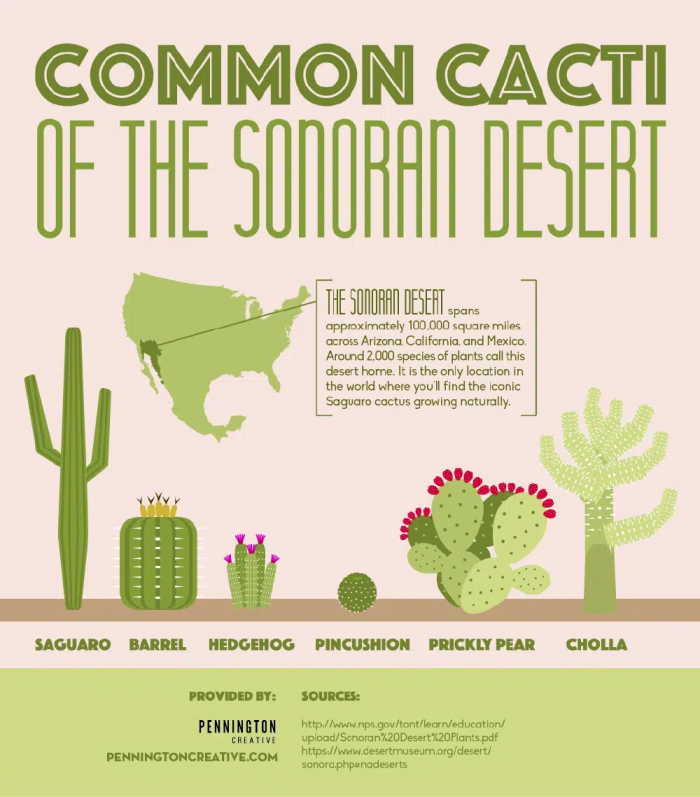
The Sonoran Desert is one of the most beautiful deserts in the world. Its mountains, cactus forests and rivers provide a home for numerous plant species, including some of the largest cacti on earth. These plants have been around for thousands of years and have adapted to survive in this harsh environment. Nowadays, people are starting to appreciate these cacti not only for their beauty but also for their usefulness. These prickly plants can be used in many ways: from food to medicine! Here are some common types that you might see as you explore this awesome landscape:
Saguaro Cactus
The saguaro cactus is the most iconic plant of the Sonoran Desert. It can grow up to 50 feet tall and 13 feet wide, with a trunk up to 6 inches thick! The saguaros prefer dry, rocky soil and thrive in the desert heat by storing water in their stems for months at a time. The longer you live in Arizona, the more likely it is that you’ll see this giant plant towering over everything else around it. Saguaros are also known as “the walking cactus” because they grow slowly–up to only 1 inch per year–and only sprout new branches when there’s enough room for them (which means no one knows how old some of these guys are). They’re also called “cardboard cacti” because their papery skin looks just like cardboard boxes! You might find other types of cacti growing alongside saguaros: barrel-shaped prickly pear; cholla (which means “spine”) covered with sharp spines; pencil barrel (with very short spines) or hedgehog(a ball covered with short spines).
Barrel Cactus
The barrel cactus is a large, columnar cactus native to the Sonoran Desert. It has a woolly base and a green or brown body, with yellow spines on the upper half. The barrel cactus can grow up to 15 feet tall. The name “barrel cactus” comes from its shape: it looks like an oversized barrel that’s been cut in half lengthwise–hence its scientific name Ferocactus cylindraceus (ferocious + cylindrical). Barrels are excellent for garden landscaping because they’re easy to grow and maintain; they don’t require much water or fertilizer and will tolerate heat well as long as there’s enough sunlight available for photosynthesis (the process by which plants turn sunlight into food).
Hedgehog Cactus
The Hedgehog Cactus is a common cactus that can be found in the Sonoran Desert, as well as other parts of the world. It’s also known by its scientific name, Echinocereus fendleri. The Hedgehog Cactus has a spiny fruit that is edible and can be used for medicine and dye. The fruits are known to have anti-inflammatory properties, making them useful against rheumatism or arthritis. They have also been used to treat syphilis because they contain saponin (a chemical compound found in many plants). Hedgehog Cacti are often used to make rope and baskets due to their strong fibers along with their ability to hold up under pressure without breaking easily like some other types of rope may do if put under too much strain from being pulled on too tightly by something heavy like an animal trying get through your fence made out only using these kinds of materials instead!
Pincushion Cactus
The pincushion cactus is a common cactus of the Sonoran Desert, and it’s also known as the hedgehog cactus. This low-growing cactus has a wide, round base that can reach up to 12 inches across and grows up to 2 feet tall. It has numerous spines that look like little balls stuck onto its skin (hence “pincushion”). Prickly Pear Cacti: Prickly Pear Cacti are native to Mexico and Central America but have been introduced into many other parts of North America because they’re so useful; they provide food for humans and animals alike!
Prickly Pear Cactus
Prickly pear cactus (Opuntia spp.) is common in the Sonoran Desert, and can be seen growing throughout the region. Prickly pear cacti are flat, round bodies with many spines that are red, yellow or purple. They can grow up to six feet tall and have flowers ranging from white to pinkish-red depending on the species. The fruits of this plant contain edible pads called tunas which were traditionally eaten by Native Americans in Southern Arizona and Northern Mexico as well as used for medicine and crafts such as making baskets or weaving blankets out of their fibers.
Cholla Cactus
Cholla cacti are a common sight in the Sonoran Desert. These prickly plants have a distinctive appearance and behavior, which makes them easy to identify. Chollas have straight or curved spines that can be up to 1/2 inch long, with smaller ones clustered around the base of each stem. The flowers are white or yellowish-green, blooming from April through June depending on location and weather conditions; they grow on tall stalks above the leaves and branches so you’ll see them easily if you’re looking for them! The most noticeable feature about chollas–and what makes them such an annoyance if you don’t want them around–is their ability to latch onto anything they touch with their barbed spines (called glochids). These little barbs will stick into clothing or skin and cause terrible itching when removed later; this is why we recommend wearing leather gloves when handling these plants!
In conclusion, there are many different kinds of cactus found in the Sonoran Desert. Some are small and prickly whereas others are large and have beautiful flowers or fruit. All of these plants have one thing in common though – they have been around for millions of years!
